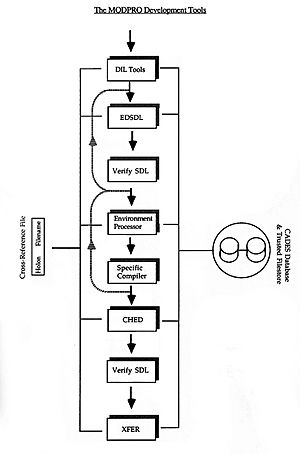CADES facts for kids
CADES (which stands for Computer Aided Design and Evaluation System) was a special computer program. It was created to help design and build the VME/B Operating System. This operating system was for the ICL New Range computers, later known as the 2900 series.
From the very beginning, the VME/B system was built using CADES. CADES wasn't just for keeping track of code versions. It was designed to manage every step of creating software. This included everything from understanding what was needed to fixing problems after the software was released.
The ideas behind CADES helped inspire later projects like the Alvey Project. This project focused on creating better tools for managing software development. Because CADES was used for over 20 years on a huge software project, the information it collected has helped many studies about how software changes over time.
Contents
How CADES Started
CADES was first thought up in 1970 by David Pearson and Brian Warboys. They worked for ICL's OSTECH group in Kidsgrove. David Pearson was a scientist who specialized in computer simulations. Brian Warboys was a main designer for another operating system called Multijob.
ICL was planning to develop a very large software system for their 2900 Series computers. This big project gave Pearson and Warboys the chance to create a new system like CADES. They wanted to solve problems like how to help designers and programmers work faster. They also wanted to make sure designs were correct and easy to test.
When designing CADES, David Pearson looked at how hardware was designed using computers. He even tried using graphics in the design process. The CADES design method was called Structural Modelling. It was very organized and used a special language called SDL. Designs written in SDL were checked by a tool called the Design Analyser. Then, they were stored in the CADES Product Database. This database was the main part of the system that held all the design information.
The goal was to test these designs using a tool called the Animator. Also, the system was supposed to automatically create the S3 programming code from the designs. CADES also managed how new versions of the system were put together. This meant that checking for problems in new versions was controlled from the very start.
Key Ideas Behind CADES
To manage the development of VME/B, the project was broken down into smaller parts. This made it easier to handle. VME/B had a main structure, like a kernel and a file store. These were divided into smaller sub-systems. Each sub-system then had different versions as it was developed.
These divisions of VME/B were organized in the CADES database. This helped developers reuse parts of the code within VME/B. This was a big goal in software engineering. CADES also had many tools and used SDL (Software Design Language) for development. It kept track of all versions and had a concept of "trusted" source code. This meant code that had passed quality checks and was stored securely in CADES. All these features helped speed up development and made sure there were good records and quality checks.
CADES used the word "holon" to describe pieces of code, like procedures. This word came from the Greek word holo, meaning "whole." It was inspired by a book called The Ghost in the Machine. David Pearson often said he thought of the CADES design while reading this book on a beach. Holons were arranged in a hierarchy, like a family tree, showing how different parts of the code were related. Holons also kept track of how they interacted with other holons. This made it easier to develop code in smaller, reusable parts. CADES also stored information about constant values and custom data types.
How CADES Was Used for Development
Developing software with CADES involved a set of tools called MODPRO (which stood for Module Processing). MODPRO acted as a link between the developer and CADES. These tools helped developers focus more on writing code and less on managing files or quality checks. Developers didn't need to know how to directly change data within CADES. The MODPRO application would create the necessary commands for them.
Using MODPRO for development didn't require special knowledge of S3 or SCL. Instead, developers used SDL, the Software Design Language. This was a simpler, higher-level language. When used with the EDSDL (Edit SDL) editor, it worked with CADES to manage new development or changes. Then, another MODPRO tool called EPETC (or Environmental Processor) used information from CADES. It made sure the final code was ready for compilation in S3 or SCL. Other tools in the MODPRO set helped with different steps, such as:
- Getting detailed information about holons using CHED (CADES Holon Environment Details).
- Interacting with CADES using DIL (Database Interface Language).
- Creating reports using CRP (CADES Report Producer).
- Moving valid files or code into or out of the secure CADES storage using XFER.
The image below shows a typical way MODPRO was used for development.
Images for kids



